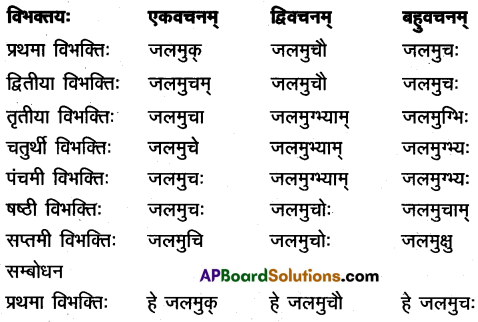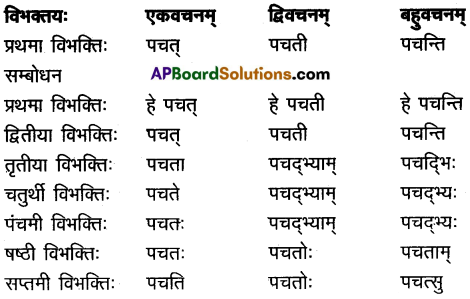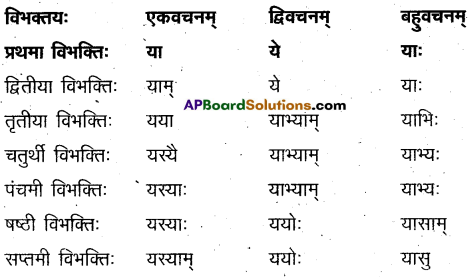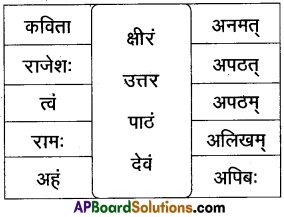Access to a variety of AP Inter 2nd Year Sanskrit Model Papers Set 9 allows students to familiarize themselves with different question patterns.
AP Inter 2nd Year Sanskrit Model Paper Set 9 with Solutions
Time : 3 Hours
Max.Marks : 100
Note :
- All questions should be attempted.
- Question Nos. 1, 2 and 3 should be answered either in the medium of instructions of the candidate or in Sanskrit (Devanagari Script) only.
- The remaining questions should be answered in Sanskrit (Devanagari Script) only.
सूचना :
प्रथम, द्वितीय, तृतीय प्रश्नान् विहाय अन्ये सर्वेऽपि प्रश्नाः संस्कृत भाषायामेव समाधातव्याः ।
1. एकस्य श्लोकस्य प्रतिपदार्थं भावं च लिखत ।
अ) तक्षकस्य विषं दन्ते मक्षिकायास्तु मस्तके |
वृश्चिकस्य विषं पुच्छे सर्वाङ्गे दुर्जने विषम् ॥
समाधान:
पदच्छेद (Word Division) : तक्षकस्य, विषं, दन्ते, मक्षिकायाः, मस्तके, वृश्चिकस्य विषं, पुच्छे, सर्वाङ्गे, दुर्जने, विषम् ।
अन्वयक्रम : तक्षकस्य, विषं, दन्ते, मक्षिकायाः, मस्तके, वृश्चिकस्य, पुच्छे, विषं, दुर्जने, सर्वाङ्गे, विषम् ।
अर्था (Meanings) : तक्षकस्य = to a serpent, विषम् = poison, दन्ते in fangs, मक्षिकायाः = to a bee or spider, मस्तके = in head (poison), वृश्चिकस्य = to a scorpion, पुच्छे = in tail, विषम् = poison, दुर्जने = to an evil person, सर्वांगे = throughout the body, विषम् = poison.
भाव (Substance) : A serpent has poison is its fangs, a bee has in its head, and a scorpion has poison in its tail. But an evil person has poison in his whole body.
आ) परोपदेशसमये जनाः सर्वेऽपि पण्डिताः ।
तदनुष्ठानसमये मुनयोऽपि न पण्डिताः ॥
समाधान:
पदच्छेद (Word Division) : परोपदेशसमये, जनाः, सर्वेः, अपि, पण्डिताः, तत्, अनुष्ठानसमये, मुनयः, अपि, न, पंडिताः ।
अन्वयक्रम : सर्वे, जनाः, अपि, परोपदेशसमये, पण्डिताः, तत्, अनुष्ठानसमये, मुनयः, अपि, न पण्डिताः ।
अर्था (Meanings) : पर + उपदेशसमये = while advising others; सर्वे अपि = all the; जनाः = people; पंडिताः = are scholars; तत् + अनुष्ठानसमयें = while putting into practice; मुनयः अपि = even the sages; न पण्डिताः = are not scholars.
भाव (Substance): While giving advice to others, everyone acts as a scholar, but while putting it into practice, even the sages are not scholars:
2. एकं निबन्धप्रश्नं समाधत्त ।
अ) क्षितीशेन वसिष्ठ धेनुः कथं आराधिता । विशदयत ?
Answer:
Introduction: The lesson Dharmanishta is an extract from the 2nd canto of Raghuvamsa, written by Kalidasa. This lesson describes the moral and devotional character of king Dilipa.
A Lion attacks Nandini: The childless king Dilipa his wife Sudakshina were engaged in the service of Nandini, the cow of sage Vasishta. One day Nandini which went to the forest guarded by the king wished to test the devotion of the king, and entered a Himalayan cave. Thinking that the cow was unassailable to any wild animal, the king took his eyes off her to watch the beauty of the mountain. Then a lion attacked her. Alerted by her cry, the king became ready to kill the lion by shooting an arrow at it. But his hand got fixed on the shaft of the arrow. चित्रार्पितारम्भ इवावतस्थे ।
Then the lion told him that he was a servant of Lord Siva. He was appointed there to protect the Devadaru tree grown by Parvathi. He was made a lion, and any animal that arrived there when he was hungry would become his food.
·
Dilipa’s offer: Then the king said that Siva was to be respected, and at the same time, the property of the teacher was to be saved. He offered his own body as food to the lion requesting the release of the cow. But the lion said that the king was young and an emperor. He seemed to be imprudent in giving up more for little. By showing compassion to the cow, she alone would be saved.
But if he lived, he could always save his people from calamities. The king said that a king should protect his subjects. राज्येन कि तद्विपरीतवृत्तेः, प्राणैः उपक्रोशमलीमसैर्वा | He could not offer other cows for Nandini, the daughter of Surabhi to his preceptor. He pleaded with the lion that how he could stand before his teacher when the cow was lost and himself was unhurt. He further said that people like him did not care for physical bodies. पिण्डेष्वनास्था खलु भौतिकेषु ।
The lion agreed and released the cow. But when the king bent his head before the lion, he received a shower of flowers from the Vidyadharas. The delighted cow, followed by the king returned safely to the hermitage.
आ) मातृभूमेः वैभवं कविः कथं प्रशशंस ?
Answer:
Introduction: The lesson Sa Matrubhumirmama was written by Dorbala Prabhakara Sarma. The poet describes the greatness of India in this poem.
Vedabhumi, Jnanabhumi and Dharmabhumi: The poet praises the motherland as a land of Vedas, wisdom, languages, gods, dharma, action, yoga, tapas, rivers, holy places and great people. Here, the cattle of the Vedas show the right path.
The people here are cultured, intelligent, healthy and sweetly speaking. यत्रैताः हृदि जागृताः प्रकृतयः सा मातृभूमिर्मम | The land is prosperous, waters are pure, breeze is purifying and life is friendly. There are Rik mantras that praise the gods, Yajush mantras that are used in sacrifices, Atharva mantras that show the path of prosperity. This land is full of knowledge with the Vedas, Upanishads, Puranas, Itihasas, Kavyas etc. विद्या यत्र परोपकारविभवाः सा ज्ञानभूमिर्मम । There are different languages belonging to Vanga, Anga, Andhra, Kerala, Maharashtra, Sindhi, Gujarati, Karnataka etc.
Selfless People: The gods of rivers, villages, cities, towns, households, lands and others bestow boons. The lords of quarters such as Indra, Agni, Varuna, Vayu, Kubera, Yama etc. along with Vishnu, Uma and others grant welfare to the people. In a household, the mother takes care of the interests of her husband and children, father works, brothers give relief, teachers preach and the elders offer advice. ग्रमे यत्र गृहे समैक्यपरता सा धर्मभूमिर्मम | The people work selflessly, are engaged in meditation, prayers and contemplation. The wisdom of the sages ensures the welfare of the world, strengthens culture and enriches the knowledge.
Rivers and holy places: Rivers like Ganga, Yamuna, Saraswati, Godavari, Krishna, Narmada etc. remove sins, diseases and obstacles. Mountains such as Hemadri, Rajatadri, Aravali, Mahendra, Himalayas, Sahya etc. embellish this land. There are holy cities such as Kasi, Ayodhya, Puri, Kanchi, Madhura, Avanti, Tirupati, Ahobilam etc. Great sages and poets like Vyasa, Valmiki, Bhrigu, Sankara, Kalidasa, Bhavabhuti etc. belonged to this land.
![]()
3. एकं निबन्धप्रश्नं समाधत्त ।
अ) भोजराजाय सालभञ्जिकया उक्त विक्रमस्य औदार्यं लिखत ।
Answer:
Introduction: The lesson Vikramasya Audaryam is taken from vikramarkacharitam written by Sivadasa. When Bhoja wants to ascend the throne of Vikrama the statue on the fourth step tells this story about the generosity of king Vikrama.
The childless Brahmin:
While Vikramaditya ruled Ujjaini, there was a learned Brahmin in that city, who was virtuous, but who had no children. Once, his wife said to him that there was no heaven for one who had no children सत्पुत्रेण कुलं नृपेण वसुधा लोकत्रयं भानुना | The Brahmin worshipped Lord Siva. The god appeared in his dream and asked him to perform Pradoshavrata. The Brahmin did so and he begot a son, whom he named Devadatta. When his son grew up, the Brahmin performed his marriage, and went on a pilgrimage to Varanasi.
Devadatta’s help to Vikrama :
Once Devadatta went into the forest to collect fuel sticks for sacrifice. At that time, king Vikrama came to the forest for hunting. There he asked Devadatta the way to the city, even though he knew it.
Devadatta himself led him to the city. The king praised him, and appointed him in his court. One day the king praised Devadatta’s help in the assembly saying that he could never repay his debt.
Devadatta kidnaps the prince :
Devadatta wondered whether the king’s praise was true or false. He wanted to test the words of the king. He kidnapped the prince, and gave one of his ornaments to his servant and sent him to the market to sell it. The king’s men who were searching for the prince caught him, and brought him to the king. When the king asked him, the servant said that he was Devadatta’s servant. The king sent for Devadatta, who said that he killed the prince or money. The members of the court said that Devadatta should be sentenced to death. But the king said that Devadatta rescued him in the forest. One should not find faults in those dependent on him. नैवश्रितेषु महतां गुणदोषचिन्ता | He said that his son died because of his previous deeds only. He honoured Devadatta and sent him away.
Devadatta returned with the prince, and told the king that he wanted to test the words of the king. He praised the generosity of the king, who said that one should not forget the help done to him. यः कृतमुपकारं विस्मरति स एव पुरुषाधमः |
Thus the statue told Bhoja about the generosity of king Vikrama.
आ) वेङ्कटरावस्य स्वभावं संग्रहेण लिखत ।
Answer:
Introduction: The lesson Bhishajah Bhaishajyam was written by Prof. Pullela Sriramachandra. It is taken from his Sriramachandra-laghukavya-sangraha. This lesson describes the story of a selfish doctor, and the fruit he reaped for his selfishness.
The Villager’s Plea: One day some villagers came to Dr. Venkata Rao, and requested him to attend to a boy who was injured in an accident. Venkata Rao childed them for not coming in time. वैद्योऽपि मानव एव | He accused them of trying to get treatment done without paying fee. He insulted them saying the boy would be delicate as the baby of a donkey. When they left as the boy was serious क्षणे क्षणे किल परिक्षीयते बालस्य दशा, Venkata Rao thought nothing would happen if one puppy died.
The poor and intelligent Venkata Rao: Venkata Rao was the son of a poor farmer. He was very intelligent and secured a seat in medical college. His father sold their agricultural land for his education. A rich man married his daughter to Venkata Rao: Venkata Rao’s practice also picked up. Along with money, the three defects grew in him. They were considering others as insects, himself as god, and accepting others praise as the truth. When he spoke of his father as a beggar, his father left him and returned to their village.
Marriage was also a business affair for Venkata Rao. faarst नाम वणिग्व्यवहार एव । For him money was everything. He never loved his wife. His son Suresh alone became the object of his affection.
Desire for Power: Venkata Rao thought that money was useless without power. He became an MLA twice. But he could not become a minister. He was unhappy about that. He could not win the seat the third time. He blamed the people for that. His hatred for people grew.
Manjuhasini, the Lady Doctor : At that time, Dr. Manjuhasini joined the government hospital there. She was Venkata Rao’s classmate in medical college. She rejected Venkata Rao’s advances. Venkata Rao was hoping that she might have changed now as he became rich.
The death of his son : Venkata Rato received a phone call from Manjuhasini requesting his help in an emergency case. His driver tried to inform him that his son was not there at the school when he went there after getting the brake repaired. Venkata Rao cut him short saying that the boy would have reached home. But when he went to the hospital he saw the same villagers who came to him earlier in the day, and the body of his dead son.
4. त्रयाणां प्रश्नानां समाधानानि लिखत ।
अ) कर्णभारं केन विरचितम् ?
समाधान:
कर्णभारं भासेन विरचितम् ।
आ) नृपश्रियः कीदृशा: ?
समाधान:
नृपश्रियः भुजङ्गजिह्वाचपला ।
इ) केन द्रुपदः गर्वान्धः जातः ?
समाधान:
द्रुपदः धनश्रिया गर्वान्धः जातः । एवम् अर्जुनः उक्तवान् ।
ई) बालानां कलहः कीदृश: ?
समाधान:बालानां कलहः तत्कालीनः भवति । बालाः कलहायन्ते अनन्तरं क्रीडन्ते च ।
उ) कालिदासेन उक्तस्य श्लोकस्य भावः कः ?
समाधान:
अहं खादन् न गच्छामि, हसन् न जल्पामि गतं न शोचामि कृतं न स्मरामि, द्वयोः संभाषणमध्ये न प्रविशामि । तेन कथम् अहं मूर्खः भवामि ।
ऊ) कालिदासः महाराजं कथं सन्तोषितवान् ?
समाधान:
भोजस्य मनोगतस्य यथोचितम् उत्तरं दत्वा कालिदासः भोजं संतोषितवान् ।
![]()
5. द्वयोः संदर्भ व्याख्यानं लिखत ।
अ) परेषां सहसावज्ञा न कर्तव्या कथञ्चन ।
समाधान:
परिचयः – एतत् वाक्यं विभीषणोपदेशः इति पाठ्यभागात् स्वीकृतम् । एषः पाठः रामायणस्य युद्धकाण्डात् गृहीतः । अस्य कविः वाल्मीकिः ।
सन्दर्भः – प्रदीयतां दाशरथाय मैथिली इति रावणं प्रति उपदिशन् विभीषणः एवं वदति ।
भावः परेषां बलानि अपरिमेयानि । तेषां सहसा अवज्ञा न कुर्यात् ।
आ) राज्येन किं तद्विपरीतवृत्तेः प्राणैः उपक्रोशमलीमसैर्वाः ।
समाधान:
परिचयः एतत् वाक्यं ‘धर्मनिष्ठा’ इति पाठ्यभागात् स्वीकृतम्, एषःभागः कालिदासस्य रघुवंश महाकाव्ये पञ्चमसर्गात् स्वीकृतः ।
सन्दर्भः दिलीपः सिरं प्रति एवं वदति ।
भावः अक्षत्रविरुद्धवृत्तेः राज्येन किं प्रयोजनम् निन्दया मलिनयुतं प्राणेन किं प्रयोजनम् ।
विवरणम्ः क्षत्रियः राज्यं पालयति, स्वपराक्रमेन धर्म पालयति, आक्षितान् रक्षति ।
इ) विद्या यत्र परोपकारविभवाः सा ज्ञानभूमिर्मम ।
समाधान:
परिचयः – एतत् वाक्यं सा मातृभूमिर्मम इति पाठ्यभागात् स्वीकृतम् । अस्य कविः श्रीमान् दोर्बल प्रभाकरशर्मा ।.
सन्दर्भः – मातृभूमेः वैशिष्ट्यं वर्णयन् मम मातृभूमिः ज्ञानभूमिः, धर्मभूमिः इति वदन् कविः एवं वर्णयति ।
भावः – यत्र वेदाः उपनिषदः, पुराणेतिहासाः आयुर्योगधर्मसङ्गीतग्रन्थाः च परोपकारविभवाः भवन्ति सा ज्ञानभूमिः मम मातृभूमिः इति कविः वदति ।
ई) भृत्या हि पक्त्री वद किं न सा स्त्री ।
समाधान:
परिचय : गतत् वाक्यं ‘नित्रविंशतिः’ इति पाठ्यभागात् स्वीकृतम्’ अस्य : पाठ्यभागस्य रचयिता जटावल्लभपुरुषोत्तम शास्त्री ।
सन्दर्भ : लोके चित्रविषयान् वर्णयन् कविः एवं वदति । मम सुता महानसे न निरोधनीया, स्त्रियः पूज्याः इति चित्रं वदन्ति । तर्हि भूक्तिः कथं सिद्ध्यति इति कविः पृच्छति ।
भाव : या भृत्या पचति सा स्त्री नास्ति किम् ?
विवरणम् : मदीया कन्या महानसे नैव पाकं कराति ? स्त्रियः पूज्याः, इति वदन्ति, भृत्या पाचिका स्त्री कि ? वद ।
6. द्वयोः ससंदर्भ व्याख्यानं लिखत ।
अ) निवृत्तरागस्य गृहं तपोवनम् ।
समाधान:
परिचयः एतत-वाक्यं, “मन्दविषसर्पकथा” इति पाठ्यभागात् स्वीकृतम् अस्य पाठ्यभागस्य रचयिता नारायणपण्डितः ।
सन्दर्भः तपःकर्तुं बनाय प्रस्थितं कौण्डिन्यं प्रति कपिलः एवं अवदत् । भावः विरक्तस्य जनस्य गृहमेव तपोवल तुल्यम् ।
विवरणम्ः सर्वे पञ्चेन्दियाणि वशेयुः, तदा एव तस्य शान्तिः सिध्यति, तस्मिन् समये गृहः एव तपोवनसदृशम् ।
आ) नैवाक्षितेषु महतां गुणदोषचिन्ता |
समाधान:
परिचयः – इदं वाक्यं “विक्रमस्य औदार्यम्” इति पाठ्यभागात् स्वीकृतम् । अस्य पाठस्य रचयित शिवदास ।
सन्दर्भः समामध्ये राजा सचिवानां प्रति एवं अवदत् ।
भावः – शरणागतेषु महतां गुणदोष चिन्ता न कुर्तव्या ।
विवरणम्ः – चन्द्रः क्षथी, प्रकृतिवक्रतनु, कलडिए तथापि सः शकरं आश्रितवान् सः शंकरः चन्द्रस्य गुणदोषचिन्तनं ।
इ) वैद्योऽपि मानव एव ।
समाधान:
परिचयः वेङ्कटरावस्य भिषजो भैषज्यम् इति पाठ असित अस्य पाठस्य रचयित, श्री पुल्लेल श्रीरामचन्द्रः ।
सन्दर्भः वेङ्कटरावः ग्रामीणं प्रति एवं अवदत् ।
भावः वैद्यः अपि चरः एव ।
विवरणम्ः अरे भूर्ख ! स्वसुखनिन्तैव युषमाकम् वैद्यः मानवमात्र एव ।
ई) अप्पय्यः असाधारणः वादे जेतुमशक्तः ।
समाधान:
परिचयः – एतत् वाक्यम् अप्पय्यदीक्षितेन्द्र इति पाठ्यभागात् स्वीकृतम् । अस्य रचयित्री सङ्का उषाराणी ।
सन्दर्भः – अप्पय्यं जेतुं, स्वपादावनतं कर्तुं च रत्नखेटश्रीनिवासः अभिलषति स्म । तदर्थं सः काञ्चीपुरे कामाक्षी प्रार्थितवान् । तदा देवी कामाक्षी अप्पय्यं जेतुं न शक्यते । तव पुत्रिकां तस्मै विवाहे प्रयच्छ इति उक्तवती ।
भावः – अप्पय्यः असामान्यः । वादे तं जेतुं न शक्यते ।
7. त्रयाणां प्रश्नानां समाधानानि लिखत ।
अ) सीता कीदृशी ?
समाधान:
सीता महाहिसदृशी । सीतायाः चिन्ता एव विषम्, स्मित एव दंष्ट्राः स्तनौ एव भोगाः तथा अङ्गुल्यः एव शिरांसि ।
आ) सुदक्षिणादिलीपौ किमर्थं नन्दिनीधेनोः सेवाम् अकरुताम् ?
समाधान:
सुदक्षिमादिलीपौ सन्तानार्थं नन्दिनीधेनोः सेवाम् अकुरुताम् ।
इ) पृथिव्यां त्रीणि रत्नानि कानि ?
समाधान:
पृथिव्यां त्रीणि रत्नानि जलं, अन्नं, सुभाषितम् ।
ई) देवः कुत्र सहायकृते भवति ?
समाधान:
उद्यमं, साहस, धैर्यं, बुद्धिः, शक्तिः, पराक्रमः यत्र वर्तन्ते तत्र सहायकृत् भवति ।
उ) लोके चित्रमतिः कः ?
समाधान:
ईश्वरे भक्तिः सर्वेषां अस्ति, ईश्वरप्रतिपादित वेदे भक्तिः नास्ति, एतत् लोके चित्रगतिः ।
ऊ) सर्वप्राणिनामुपकारकारि किम् ?
समाधान:
सर्वप्राणइनाम् उपकारकारि सुमहत् आर्षविज्ञानामृतम् ।
8. त्रयाणां प्रश्नानां समाधानानि लिखत ।
अ) हितोपदेशे कति भागाः सन्ति ? ते च के ?
समाधान:
हितोपदेशे चत्वारः भागाः सन्ति । ते
1. मित्रलाभः 2. मित्रभेदः 3. विग्रहः 4. सन्धिः
आ) ब्राह्मणः प्रति तत्प्रेयसी किं जगाद ?
समाधान:
ब्राह्मणं प्रति तत्प्रेयसी एवं जगाद अपुत्रस्य गतिर्नास्ति स्वर्गो नैव च नैव च । सत्पुत्रेणैव कुलं प्रकाशते इति ।
इ) धर्मपालस्य कति पुत्राः ? ते च के ?
समाधान:
धर्मपालस्य त्रयः पुत्रः आसन् । ते च सुमन्त्रः, सुमित्रः कामपालः च ।
ई) श्रीधरः स्वमातुः मरणसमये किं कुर्वन्नासीत् ?
समाधान:
श्रीधरः स्वमातुः मरणसमये विश्वविद्यालये शोधग्रन्थसमर्पणकार्यं कुर्वन् आस्ते ।
उ) मञ्जुहासिनी का ?
समाधान:
मञ्जुहासिनी आत्मनः प्रेयसी ।
ऊ) अप्पय्यदीक्षितः आन्ध्रभाषां कथं प्रशशंस ?
समाधान:
आन्ध्रत्वम् आन्ध्रभाषा च नाल्पस्य तपसः फलम् इति अप्पय्यः आन्ध्रभाषां प्रशसंश
9. एकेन वाक्येन समाधानं दत्त ।
अ) सुखधर्मनाशनं केन भवति ?
समाधान:
सुखधर्मनाशनं कोपेन भवति ।
आ) रघुवंशमहाकाव्यं केन विरचितम् ?
समाधान:
कालिदासेन
इ) कैः पाषाणखण्डेषु रत्नसंज्ञा विधीयते ?
समाधान:
मूढैः
ई) पापहरा नदी का ?
समाधान:
पापहरा नदी गङ्गा ।
उ) देहे सदा प्राण इव का अस्ति ?
समाधान:
धिषणा
![]()
10. एकेन वाक्येन समाधानं दत्त ।
अ) मण्डूकनाथः कः ?
समाधान:
जालपादः
आ) देवदत्तः राजानं कुत्रं अनीनयत् ?
समाधान:
नगरम्
इ) राजहंसस्य पत्नी का ?
समाधान:
वसुमती
ई) श्रीधरस्य ज्येष्ठभ्रातृवत् कः वर्धते ?
समाधान:
श्रीधरस्यं ज्येष्ठभ्रातृवत् तस्य मातुः कासः वर्धते ।
उ) अप्पय्यदीक्षितः कस्य पुत्रः ?
समाधान:
अप्पय्यदीक्षितः रङ्गराजाध्वरेः पुत्रः ।
11. अधोनिर्दिष्टं कथां पठित्वा प्रश्नानां समाधानानि दत्त |
अस्ति मगधदेशे चम्पकवतीनाम अरण्यानी। तस्यां चिरात् महता र्नेहेन मृगकाकौ निवसतः। स च मृगः स्वेच्छया भ्राम्यन् हृष्टपुष्टाड़्ड केनचित् शृगालेन अवलोकितः। तं दृष्ट्वा शृगालोऽचिन्तयत् – आह – ‘कथम् एतन्मासं सुललितं भक्षयामि ? भवतु । विश्वासं तावदुत्पादयामि” इत्यालोच्य उपसृत्य अब्रवीत् “मित्र ! कुशलं ते” इति । मृगेणोक्तम् – “कस्त्वम्” ? इति । स ब्रूते “क्षुद्रबुद्धिर्नाम जम्बुकोऽहम् । अत्र आरण्ये बन्धुहीने मृतवत् एकाकी निवसामि । इदानीं त्वां मित्रमासाद्य पुनः सबन्धुर्जीवलोकं प्रविष्टोऽस्मि। अघुना तवानुचरेण मया भवितव्यम्”। मृगेणोक्तम् – “एवमस्तु” इति ।
प्रश्ना:
(1) चम्पकवतीनाम अरण्यानी कुत्र अस्ति ?
समाधान:
चम्पकवतीनाम अरण्यानी मगधदेशे अस्ति ।
(2) मृगकाकौ कथं निवसतः ?
समाधान:
मृगकाकौ महता स्नेहेन निवसतः ।
(3) मृगः केन अवलोकितः ?
समाधान:
मृगः केनचित् शृगालेन अवलोकितः ।
(4) जम्बुकस्य नाम किम् ?
समाधान:
जम्बुकस्य नाम क्षुद्रबुद्धिः ।
(5) शृगालः मृगं दृष्ट्वा किमचिन्तयत् ?
समाधान:
शृगालः मृगं दृष्ट्वा “कथं एतन्मासं सुललितं भक्षयामि ? भवतु । विश्वासं” तावदुत्पादयामि इति अचिन्तयत ।
12. नामनिर्देशपूर्वकं त्रीणि सन्धत्त ।
अ) सद् + जनः
समाधान:
सज्जनः = श्चुत्व सन्धिः
आ) रामस् + टीकते
समाधान:
रामष्टीकते = ष्टुत्व सन्धिः
इ) वाक् + ईशः
समाधान:
वागीशः = जश्त्व सन्धिः
ई) जगत् + नाथः
समाधान:
जगन्नाथ: अनुनासिक संन्धिः
उ) कः + अपि
समाधान:
कोऽपि विसर्ग सन्धिः
ऊ) पितुः + इच्छा
समाधान:
पितुरिच्छा विसर्गरेफादेश सन्धिः
13. नामनिर्देशपूर्वकं त्रीणि विघटयत ।
अ) मनश्चलति
समाधान:
मनस् + चलति = श्चुत्व सन्धिः
आ) उड्डयनम्
समाधान:
उत् + डयनम् = ष्टुत्व सन्धिः
इ) अजन्तः
समाधान:
अच् + अन्तः = जश्त्व सन्धिः
ई) तन्मात्रम्
समाधान:
तत् + मात्रम् = अनुनासिक सन्धिः
उ) रामोऽपि
समाधान:
रामः + अपि = विसर्ग सन्धिः
ऊ) हरिर्गच्छति
समाधान:
हरिः + गच्छति = विसर्गरेफादेश सन्धिः
14. द्वयोः शब्दयोः सर्वविभक्तिरूपाणि लिखत ।
अ) जलमुक्
समाधान:

आ) स्रज्
समाधान:

इ) पचत्
समाधान:

ई) यद् (स्त्री)
समाधान:

15. समासनामनिर्देशपूर्वकं त्रयाणां विग्रहवाक्यानि लिखत ।
अ) विद्यानिपुणः
समाधान:
विद्यया निपुणः = तृतीयातत्पुरुष समासः
आ) स्नातानुलिप्ताः
समाधान:
स्नाताश्च ते अनुलिप्ताश्च = विशेषणपूर्वपद कर्मधारय समासः
![]()
इ) त्रिलोकी
समाधान:
त्रयाणां लोकानां समाहारः = द्विगु समासः
ई) धर्मार्थकामाः
समाधान:
धर्मः च अर्थः च कामः च = द्वन्द्व समासः
उ) शाकप्रति
समाधान:
शाकस्य लेशः = अव्ययीभाव समासः
ऊ) सहपुत्रः
समाधान:
पुत्रेण सह वर्तते इति = सहपूर्वपदबहुव्रीहि समासः
16. अधोनिर्दष्टपट्टिकामाधारीकृत्य पञ्चसाधुवाक्यानि लिखत ।

प्रश्ना:
1. कविता पाठ अपठत्
2. राजेशः देवं अनमत्
3. त्वं क्षीरं अपिवः
4. रामः देवं अनमत्
5. अहं पाठं अलिखम्